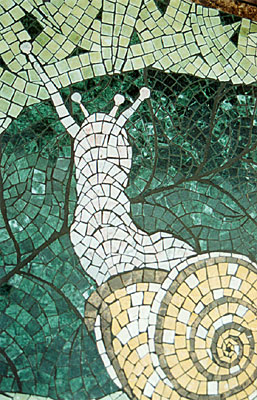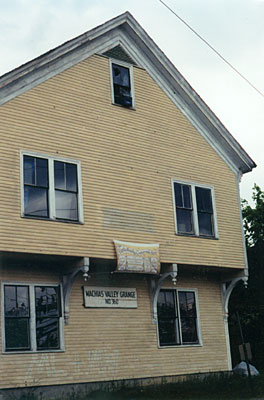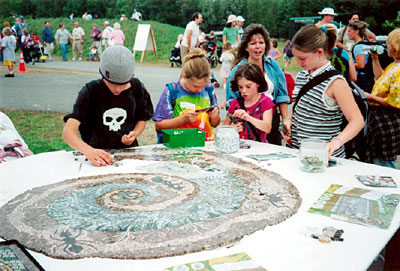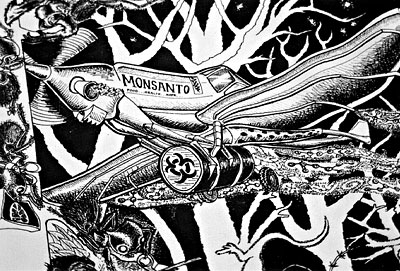 |
| Detail of a Beehive mosaic. Even good color photos give only a rough idea of the actual appearance of Beehive Collective mosaics, especially larger ones. Black and white photos of the mosaics are even more misleading. “No photo does justice to their work,” says MOFGA board member Sharon Tisher. If possible, interested readers should try to see these mosaics in person. English photo. |
By Larry Lack
The Beehive Collective is offering MOFGA an unusual present. As a tribute to MOFGA and its contributions to agriculture, the Machias-based collective is designing a stone mosaic depicting contemporary agriculture at a critical crossroads. The mosaic will illustrate the history of agriculture and contrast the sustainable path that MOFGA practices and promotes with the unsustainable road of industrial, biotech-based agriculture. The collective is already raising funds for what it says will be an entirely self-financed project, and members hope the “monumental” mosaic they plan to create over the next five years will occupy the central part of the floor in the exhibition hall at MOFGA’s Common Ground Education Center in Unity.
MOFGA’s response to this offer has been a mix of appreciation and caution. The collective, composed mostly of people in their twenties, is distinctly unorthodox in its approach to art, work and life, and this “may make us hard for some people to figure out,” says one collective member. (The ‘bees,’ as they call themselves for intentional anonymity, didn’t want me to use their names in this article.) As one bee explain it, “We’re working to take the ‘who made it and how much did it cost?’ out of art. Instead, we see ourselves as ‘cultural workers,’ by serving the crucial need for explanations of the complicated issues that our society is facing, in more accessible formats that transcend the boundaries of language and learning styles. It’s funny, we don’t even call what we do art; we think of it as visual communication. The majority of our focus is on creating healthy, collaborative processes in which we translate what information and ideas we have solicited from others into the images you see in our anti-copyright, free-to-reproduce graphics.” MOFGA board member Sharon Tisher comments: “Whatever they want to call it, I think the collective’s mosaic work is beautiful and a very interesting way to convey meaning. We’re working on a process to ensure that it fits in our ‘common ground.’”
The social mission of the collective, its effort to incorporate other people’s ideas and visions into its work, finds expression in panoramas of intense, politically charged symbolism that combine echoes of Hieronymus Bosch and elements of Diego Rivera and the Mexican muralists. But in a major divergence from the work of these artists, humans do not appear in the collective’s posters and mosaics. As a method to avoid creating allegories with human-centered, stereotypical or racially biased imagery, the bees instead use meticulously researched images of the flora and fauna specific to the bioregions that their illustrations and stories represent. Beehive graphics often feature morphed machinery embodying the technologies that threaten nature, with strikingly realistic insects shown creatively resisting these forces and celebrating alternatives.
The collective portrays insects and other animals in explicitly human situations and struggles to encourage awareness of how the choices humans are making now will dictate the future of all life. Ants are the protagonists in much of the Beehive Collective’s work, because changing society, according to a Latin American proverb that a collective member cites, is “the work of ants” – tireless, methodical, and accomplished by many nameless workers without the need for gurus or leaders.
Strongly influenced by sentiments of the anti-globalization movement presented in workshops, protests and teach-ins in Seattle, Washington, Quebec City, Genoa and elsewhere, the much-traveled Beehive Collective has created posters on several U.S and World Bank “free trade” blueprints for Latin America – Plan Colombia, Plan Puebla Panama, and the mega-scale Free Trade Area of the Americas, with future plans to create a coloring book version of this trilogy for use as an educational tool for teachers and activists. The bees are passionately dedicated to “getting the story straight” in their realistic, multicultural illustrations by interviewing people as close to ‘the source of the story’ as possible, often traveling to Latin America to collaborate directly with the farmers, indigenous people and others affected by the political situation that the posters explain. Over 35,000 of these posters have been distributed free or by donation by the bees in the course of visits to Mexico, Europe, Canada, Central and South America, and a recently completed seven-month marathon tour of the United States that included 160 workshops and presentations at high schools, colleges and community centers around the country.
Posters help fund the collective, attract Beehive collaborators, clients and supporters, and have drawn newcomers to the collective from many parts the United States and from other countries into the beehive’s apprenticeship program. Apprentices learn poster design and production as well as the group’s more distinctive artform, mosaics made from many-colored slabs of granite and marble salvaged from the scrap yards of countertop factories.
 |
| The Beehive Collective purchased and renovated the Machias Valley Grange Hall. Free concerts, films and other events are held here now. Photo by Larry Lack. |
This year the collective plans to complete its renovation of the historic Machias Valley Grange Hall in time for its 100th birthday. The bees purchased the hall in 2001 as a workspace and community center. Home to the Beehive’s apprenticeship program, this stately old building is now the scene of free weekly feature and documentary film presentations as well as concerts, songfests and other free events to which the public is invited. Collective members, apprentices and visitors seek opportunities for volunteer service in Machias and nearby communities, helping disabled people with construction, renovation and gardening work and meeting people whose ideas and visions about food and agriculture may be incorporated into the collective’s visual productions.
As work on the building winds down after this year, the bees expect that the collective will focus increasingly on the MOFGA-inspired mosaic intended for the exhibition hall at the Common Ground Education Center in Unity. According to the bees, “that mosaic will be the Beehive’s core project for the foreseeable future, even if for some reason it doesn’t end up in the exhibition hall.”
Beehive mosaics are constructed collaboratively by teams of workers using a number of techniques developed over the past seven years, during the creating and design of murals for private clients in Maine and several other states. The custom commission work of the collective can be seen on walls, floors, patios, walkways and other features of private homes as well as restaurants and other businesses. Some smaller mosaics by collective members surround wood stoves and serve as fireproof hearth pads. The basic design of each mosaic is sketched and transferred to a paper cartoon onto which the “puzzle pieces” of stone are arranged. Beehive workers then use diamond edged rotary saws, powerful hand snips and other tools to shape their large inventory of richly colored countertop stone into the precise and often intricate shapes required in the mosaic.
Special cellophane tape holds the stone pieces together and allows mosaics to be laid out and assembled in sections that can then be moved to their permanent locations. Thus the mosaic that may be destined for MOFGA can be assembled at the Beehive’s Grange Hall home in Machias and then moved to Unity for installation in the exhibition hall. The mosaic that the hive is planning for the hall will be inlaid to the yet-to-be-installed hardwood floor, so that much of the background of the images will be wood flush with the stone surface.
Explaining why the collective has chosen to offer a mosaic to MOFGA, one collective member says, gesturing emphatically toward her heart, that “people love MOFGA, for very good reasons,” and that “like many other people we’ve met and interviewed, the Beehive wants to thank MOFGA for spreading the word” about organics, grassroots technologies and community action in and beyond Maine’s rocky proving ground. In the collective’s interactive process of meeting and interviewing scores of Maine people from all walks of life, MOFGA stood out as a successful organization that works because it “draws people together around a shared vision,” inspiring teamwork, one bee says, “that’s accomplished a huge amount of solid practical work that benefits the whole community. MOFGA has helped many people to understand that the current debate about the future of food is hugely important because it will probably decide the fate of humanity and the earth.”
 |
| Visitors at the Common Ground Fair can work on mosaics at The Beehive Collective’s booth. Pieces of scrap stone are cut with strong pliers and set on a sticky surface, on which an illustration has been drawn. English photo. |
Convinced that large issues call for comparable responses, two years ago the collective asked MOFGA to consider housing a large (c. 400-square-foot) mosaic about the past, present and future of agriculture that would extend over much of the central part of the exhibition hall floor. The basic design concept would present the development and future of agriculture as a crossroads of intertwining plants. The root region would depict agriculture’s history, while at the center of the building the ongoing debate about the future of food would be illustrated by two opposed branches, one depicting the elements of sustainable and organic agriculture, the other those of industrial and biotech ag, with the future of agriculture resolving in the plant’s crown above the two branches. The symbols chosen to represent all four areas will be selected based on several hundred interviews with people involved with agriculture in Maine and elsewhere. (Beehive members know that the absence of a “blueprint” detailing the overall design of the proposed mosaic has made some MOFGA board members and activists wary of the mosaic project; the collective responds that “we don’t plan our work around a central director’s vision – our designs grow organically out of a long process of finding and interviewing collaborators and ‘storytellers’ whose suggestions from life experience working with these issues will be influencing the design and its narrative throughout the production of the mural.”)
After years of fundraising to secure and construct the fairgrounds, and faced with a need for still more money to install hardwood floors in the exhibition hall, MOFGA’s board of directors has hesitated at accepting the Beehive’s proposal of a large mosaic that would require removing some of the flooring and would put the collective’s stamp on so much of the building’s “heart of MOFGA” space. A liaison committee including MOFGA board members CR Lawn, Sharon Tisher and Spencer Aitel was appointed to work through the collective’s offer and the concerns it raised for some board members and other MOFGA activists.
Since the collective has experience in constructing mosaics in stages, with new elements added section by section to designs in progress, a decision was made (and agreed to by the collective and MOFGA’s board in a Memorandum of Understanding) to begin with a much smaller – 18-square-foot – mosaic that will be installed in the exhibition hall after approval by the liaison committee and the board. The memorandum calls this less ambitious mosaic “a small plant that may grow organically into a tree” and notes that “The project will be developed in stages, with no obligation on the part of either party to continue beyond stage I (the small mosaic) until a reasonable amount of time after (its) installation … to give us an opportunity to live with the mosaic and consider the potential and impact of its expansion.” The memorandum also specifies that the development of the larger mosaic design will be done in close consultation with the liaison committee and interested MOFGA members, and that approval of the final design must be by a “supermajority” of either 2/3 or 3/4 of MOFGA’s board.
 |
| Detail of a Beehive poster. The Collective makes very detailed posters depicting issues surrounding globalization, “free” trade, genetic engineering, and more. English photo. |
Because Beehive workers are deeply committed to a consultative approach to the work they produce, they want as many MOFGA members and supporters as possible to know about their proposal for MOFGA, so that a wide variety of perspectives can be incorporated in the work as it grows. The collective welcomes visitors at its Grange Hall home in Machias (3 Elm St., tel. 255-6737) and invites Common Ground fairgoers to visit the Beehive booth at the Fair, meet and talk with collective members, see examples of the collective’s work and discuss the proposed MOFGA mosaic (and other subjects, related or otherwise).
The Beehive workers stress that MOFGA’s views will guide the project at every stage of its development. They are sure that getting to know many more MOFGA people will build trust, resulting in decisions that the bees say “will make this work for everybody, and especially for MOFGA.” From the Beehive’s perspective, full cooperation and openness will ensure the production of a mosaic that speaks for everyone who cares about MOFGA, and they invite MOFGA members and anyone who may be interested to work with them in expressing “the spirit of organic agriculture” on the common ground of MOFGA’s much loved home.
